Identifying Modelling Issues through the Use of an Open Real-World Flood Dataset
Abstract
1. Introduction
2. Materials and Methods
2.1. Study Area
2.2. Data Collection
2.3. Hydrodynamic Simulators
2.4. Calibration Strategy
3. Results
3.1. Flood Dataset
- The maximum water depths recorded at the 44 points after the event with their coordinates in both GGRS87 and WGS84 systems, as shown in Table 2.
- The digital terrain model (DTM) of the greater area with a resolution of 5 m, as provided by the National Cadastre and Mapping Agency of Greece.
- A shape file with the boundaries of the computational area used for both HEC-RAS and MIKE FLOOD software, which coincide with the boundaries of the town of Mandra.
- A shape file with the Mandra urban blocks footprint, as were manually drawn on Google Earth platform.
- The ensemble of 100 hydrographs as depicted in Figure 2, which serve as the inflow from Agia Aikaterini catchment to Mandra town. They are derived by implementing the FLOW-R2D hydrodynamic simulator at the catchment scale, having as an input the rainfall field captured by the weather radar during the Mandra flood event [23].
- The rainfall field of the greater area with a spatial resolution of 200 m and a temporal resolution of 2 min, recorded by the X-band weather radar of the National Observatory of Athens.
3.2. Calibration Phase
3.3. Calibrated HEC-RAS vs. Informed MIKE FLOOD
4. Discussion and Concluding Remarks
Author Contributions
Funding
Data Availability Statement
Acknowledgments
Conflicts of Interest
References
- Kourtis, I.M.; Tsihrintzis, V.A. Adaptation of urban drainage networks to climate change: A review. Sci. Total Environ. 2021, 771, 145431. [Google Scholar] [CrossRef]
- Paprotny, D.; Sebastian, A.; Morales-Nápoles, O.; Jonkman, S.N. Trends in flood losses in Europe over the past 150 years. Nat. Commun. 2018, 9, 1985. [Google Scholar] [CrossRef] [PubMed]
- Shuster, W.D.; Bonta, J.; Thurston, H.; Warnemuende, E.; Smith, D.R. Impacts of impervious surface on watershed hydrology: A review. Urban Water J. 2007, 2, 263–275. [Google Scholar] [CrossRef]
- Jha, A.K.; Bloch, R.; Lamond, J. Cities and Flooding: A Guide to Integrated Urban Flood Risk Management for the 21st Century; The World Bank: Washington, DC, USA, 2012. [Google Scholar]
- Mimikou, M.A.; Baltas, E.A.; Tsihrintzis, V.A. Hydrology and Water Resource Systems Analysis; CRC Press: Boca Raton, FL, USA, 2016. [Google Scholar]
- Kourtis, I.M.; Tsihrintzis, V.A.; Baltas, E. A robust approach for comparing conventional and sustainable flood mitigation measures in urban basins. J. Environ. Manag. 2020, 269, 110822. [Google Scholar] [CrossRef]
- Kourtis, I.M.; Bellos, V.; Kopsiaftis, G.; Psiloglou, B.; Tsihrintzis, V.A. Methodology for holistic assessment of grey-green flood mitigation measures for climate change adaptation in urban basins. J. Hydrol. 2021, 603, 126885. [Google Scholar] [CrossRef]
- Theodosopoulou, Z.; Kourtis, I.M.; Bellos, V.; Apostolopoulos, K.; Potsiou, C.; Tsihrintzis, V.A. A Fast Data-Driven Tool for Flood Risk Assessment in Urban Areas. Hydrology 2022, 9, 147. [Google Scholar] [CrossRef]
- Eregno, F.E.; Nilsen, V.; Seidu, R.; Heistad, A. Evaluating the trend and extreme values of faecal indicator organisms in a raw water source: A potential approach for watershed management and optimizing water treatment practice. Environ. Process. 2014, 1, 287–309. [Google Scholar] [CrossRef]
- Yannopoulos, S.; Eleftheriadou, E.; Mpouri, S.; Giannopoulou, I. Implementing the requirements of the european flood directive: The case of ungauged and poorly gauged watersheds. Environ. Process. 2015, 2, 191–207. [Google Scholar] [CrossRef]
- Ullah, H.; Akbar, M. Drought risk analysis for water assessment at gauged and ungauged sites in the low rainfall regions of Pakistan. Environ. Process. 2021, 8, 139–162. [Google Scholar] [CrossRef]
- Razmi, A.; Mardani-Fard, H.A.; Golian, S.; Zahmatkesh, Z. Time-varying univariate and bivariate frequency analysis of nonstationary extreme sea level for New York City. Environ. Process. 2022, 9, 8. [Google Scholar] [CrossRef]
- Bellos, V.; Kourtis, I.M.; Moreno-Rodenas, A.; Tsihrintzis, V.A. Quantifying Roughness Coefficient Uncertainty in Urban Flooding Simulations through a Simplified Methodology. Water 2017, 9, 944. [Google Scholar] [CrossRef]
- Bellos, V.; Nalbantis, I.; Tsakiris, G. Friction Modeling of Flood Flow Simulations. J. Hydraul. Eng. 2018, 144, 04018073. [Google Scholar] [CrossRef]
- Ramirez, A.I.; Herrera, A. Forensic hydrology. In Forensic Analysis—From Death to Justice; Shetty, B.S.K., Padubidri, J.R., Eds.; IntechOpen: London, UK, 2016. [Google Scholar]
- Alcrudo, F.; Mulet, J. Description of the Tous dam break case study (Spain). J. Hydraul. Res. 2007, 45 (Suppl. 1), 45–57. [Google Scholar] [CrossRef]
- Diakakis, M.; Andreadakis, E.; Nikolopoulos, E.I.; Spyrou, N.I.; Gogou, M.E.; Deligiannakis, G.; Katsetsiadou, N.K.; Antoniadis, Z.; Melaki, M.; Georgakopoulos, A.; et al. An integrated approach of ground and aerial observations in flash flood disaster investigations. The case of the 2017 Mandra flash flood in Greece. Int. J. Disaster Risk Reduct. 2019, 33, 290–309. [Google Scholar] [CrossRef]
- Testa, G.; Zuccalà, D.; Alcrudo, F.; Mulet, J.; Soares-Frazão, S. Flash flood flow experiment in a simplified urban district. J. Hydraul. Res. 2007, 45, 37–44. [Google Scholar] [CrossRef]
- Haltas, I.; Tayfur, G.; Elci, S. Two-dimensional numerical modeling of flood wave propagation in an urban area due to Ürkmez dam-break, İzmir, Turkey. Nat. Hazards 2016, 81, 2103–2119. [Google Scholar] [CrossRef]
- Tegos, A.; Ziogas, A.; Bellos, V.; Tzimas, A. Forensic Hydrology: A Complete Reconstruction of an Extreme Flood Event in Data-Scarce Area. Hydrology 2022, 9, 93. [Google Scholar] [CrossRef]
- Zotou, I.; Bellos, V.; Gkouma, A.; Karathanassi, V.; Tsihrintzis, V.A. Using Sentinel-1 imagery to assess predictive per-formance of a hydraulic model. Water Resour. Manag. 2020, 34, 4415–4430. [Google Scholar] [CrossRef]
- Varlas, G.; Anagnostou, M.N.; Spyrou, C.; Papadopoulos, A.; Kalogiros, J.; Mentzafou, A.; Michaelides, S.; Baltas, E.; Karymbalis, E.; Katsafados, P. A multi-platform hydrometeorological analysis of the flash flood event of 15 November 2017 in Attica, Greece. Remote Sens. 2019, 11, 45. [Google Scholar] [CrossRef]
- Bellos, V.; Papageorgaki, I.; Kourtis, I.; Vangelis, H.; Kalogiros, I.; Tsakiris, G. Reconstruction of a flash flood event using a 2D hydrodynamic model under spatial and temporal variability of storm. Nat. Hazards 2020, 101, 711–726. [Google Scholar] [CrossRef]
- Diakakis, M.; Deligiannakis, G.; Andreadakis, E.; Katsetsiadou, K.N.; Spyrou, N.I.; Gogou, M.E. How different surrounding environments influence the characteristics of flash flood-mortality: The case of the 2017 extreme flood in Mandra, Greece. J. Flood Risk Manag. 2020, 13, e12613. [Google Scholar] [CrossRef]
- Spyrou, C.; Varlas, G.; Pappa, A.; Mentzafou, A.; Katsafados, P.; Papadopoulos, A.; Anagnostou, M.N.; Kalogiros, J. Implementation of a Nowcasting Hydrometeorological System for Studying Flash Flood Events: The Case of Mandra, Greece. Remote Sens. 2020, 12, 2784. [Google Scholar] [CrossRef]
- Mitsopoulos, G.; Panagiotatou, E.; Sant, V.; Baltas, E.; Diakakis, M.; Lekkas, E.; Stamou, A. Optimizing the Performance of Coupled 1D/2D Hydrodynamic Models for Early Warning of Flash Floods. Water 2022, 14, 2356. [Google Scholar] [CrossRef]
- Mitsopoulos, G.; Diakakis, M.; Panagiotatou, E.; Sant, V.; Bloutsos, A.; Lekkas, E.; Baltas, E.; Stamou, A.I. How would an extreme flood have behaved if flood protection works were built? the case of the disastrous flash flood of November 2017 in Mandra, Attica, Greece. Urban Water J. 2022, 19, 1–11. [Google Scholar] [CrossRef]
- Bournas, A.; Baltas, E. Investigation of the gridded flash flood Guidance in a Peri-Urban basin in greater Athens area, Greece. J. Hydrol. 2022, 610, 127820. [Google Scholar] [CrossRef]
- Tsakiris, G.; Bellos, V. A Numerical Model for Two-Dimensional Flood Routing in Complex Terrains. Water Resour. Manag. 2014, 28, 1277–1291. [Google Scholar] [CrossRef]
- Brunner, G.W. HEC-RAS, River Analysis System Hydraulic Reference Manual, Version 6.0; Report Number CPD-69, Hydrologic Engineering Center; US Army Corps of Engineers: Davis, CA, USA, 2020. [Google Scholar]
- DHI Water & Environment. MIKE 11-A Modelling System for Rivers and Channels Reference Manual; DHI Water & Environment: Hørsholm, Denmark, 2009. [Google Scholar]
- DHI Water &Environment. MIKE 21 Flow Model-Hydrodynamic Model User Guide; DHI Water & Environment: Hørsholm, Denmark, 2011. [Google Scholar]
- Bellos, V.; Tsakiris, G. Comparing Various Methods of Building Representation for 2D Flood Modelling in Built-Up Areas. Water Resour. Manag. 2014, 29, 379–397. [Google Scholar] [CrossRef]
- Tscheikner-Gratl, F.; Zeisl, P.; Kinzel, C.; Leimgruber, J.; Ertl, T.; Rauch, W.; Kleidorfer, M. Lost in calibration: Why people still do not calibrate their models, and why they still should—A case study from urban drainage modelling. Water Sci. Technol. 2016, 74, 2337–2348. [Google Scholar] [CrossRef] [PubMed]
- Saltelli, A.; Ratto, M.; Andres, T.; Campolongo, F.; Cariboni, J.; Gatelli, D.; Saisana, M.; Tarantola, S. Global Sensitivity Analysis: The Primer; John Wiley & Sons, Ltd.: Hoboken, NJ, USA, 2008; pp. 1–292. [Google Scholar] [CrossRef]
- Christelis, V.; Hughes, A.G. Metamodel-assisted analysis of an integrated model composition: An example using linked surface water—Groundwater models. Environ. Model. Softw. 2018, 107, 298–306. [Google Scholar] [CrossRef]
- Bournas, A.; Baltas, E. Increasing the Efficiency of the Sacramento Model on Event Basis in a Mountainous River Basin. Environ. Process. 2021, 8, 943–958. [Google Scholar] [CrossRef]
- Sobol, I.M. Sensitivity analysis for non-linear mathematical models. Math. Model. Comput. Exp. 1993, 1, 407–414. Available online: http://www.andreasaltelli.eu/file/repository/sobol1993.pdf (accessed on 24 August 2022).
- Morris, M.D. Factorial Sampling Plans for Preliminary Computational Experiments. Technometrics 1991, 33, 161. [Google Scholar] [CrossRef]
- Campolongo, F.; Cariboni, J.; Saltelli, A. An effective screening design for sensitivity analysis of large models. Environ. Model. Softw. 2007, 22, 1509–1518. [Google Scholar] [CrossRef]
- Pianosi, F.; Sarrazin, F.; Wagener, T. A Matlab toolbox for Global Sensitivity Analysis. Environ. Model. Softw. 2015, 70, 80–85. [Google Scholar] [CrossRef]
- Bellos, V.; Tsihrintzis, V. Uncertainty aspects of 2D flood modelling in a benchmark case study. In Proceedings of the 17th Conference on Environmental Science and Technology (CEST2021), Athens, Greece, 1–4 September 2021. [Google Scholar]
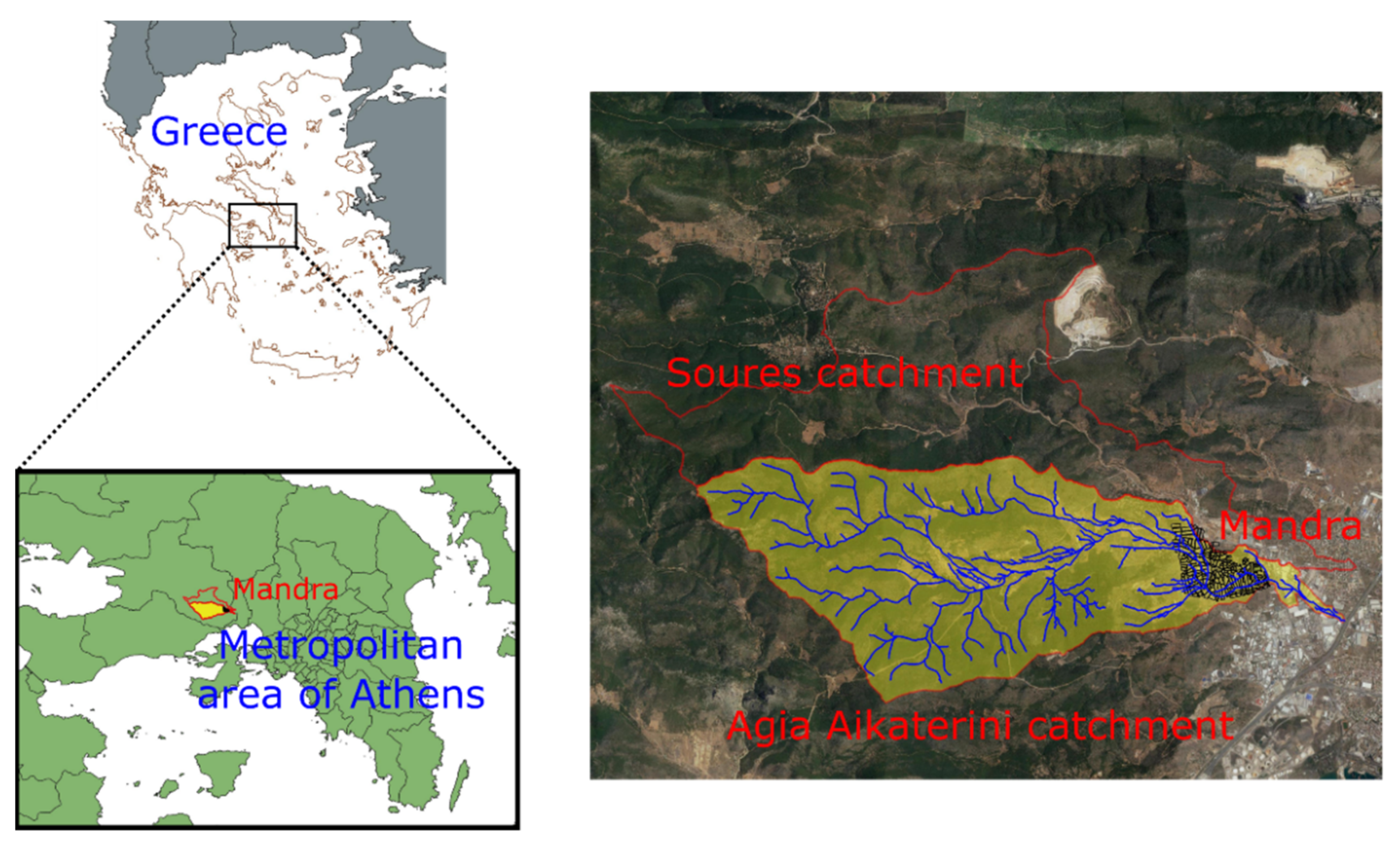
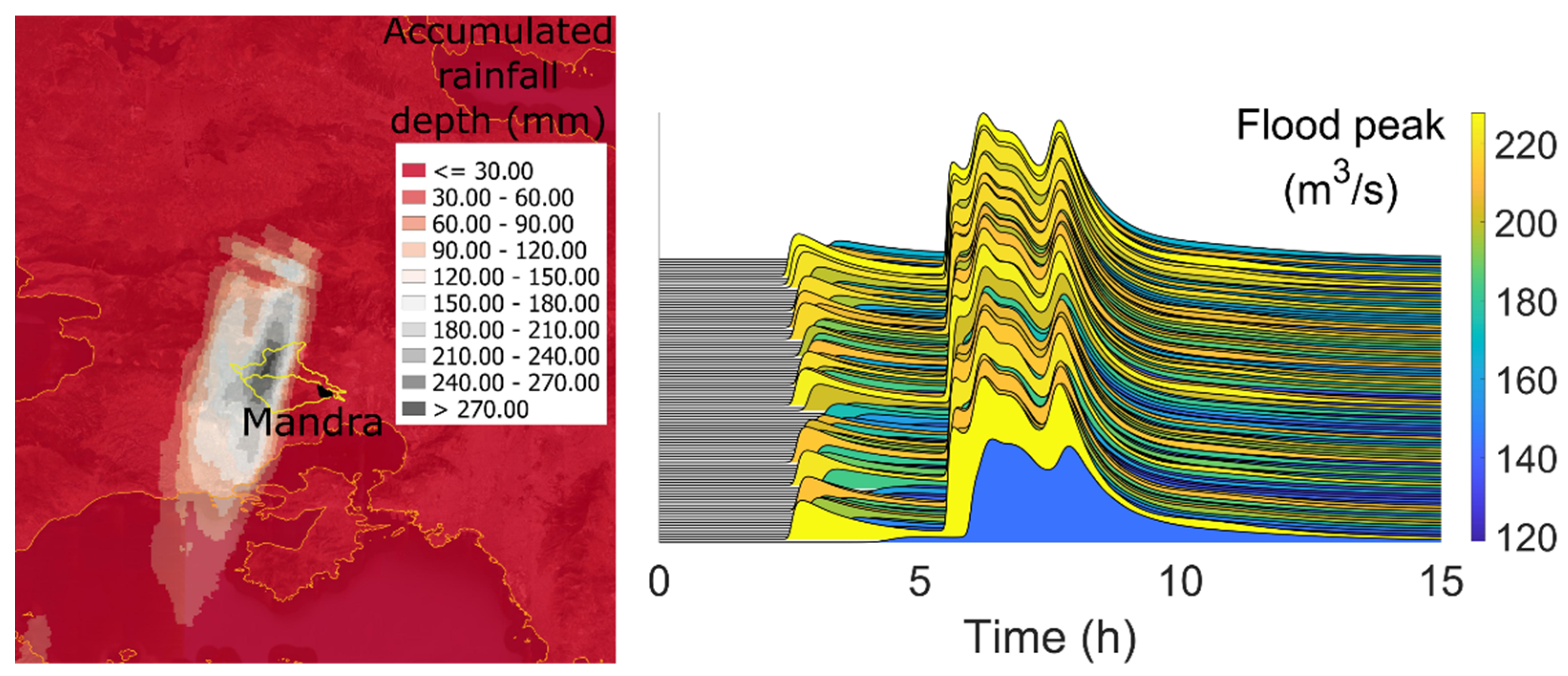
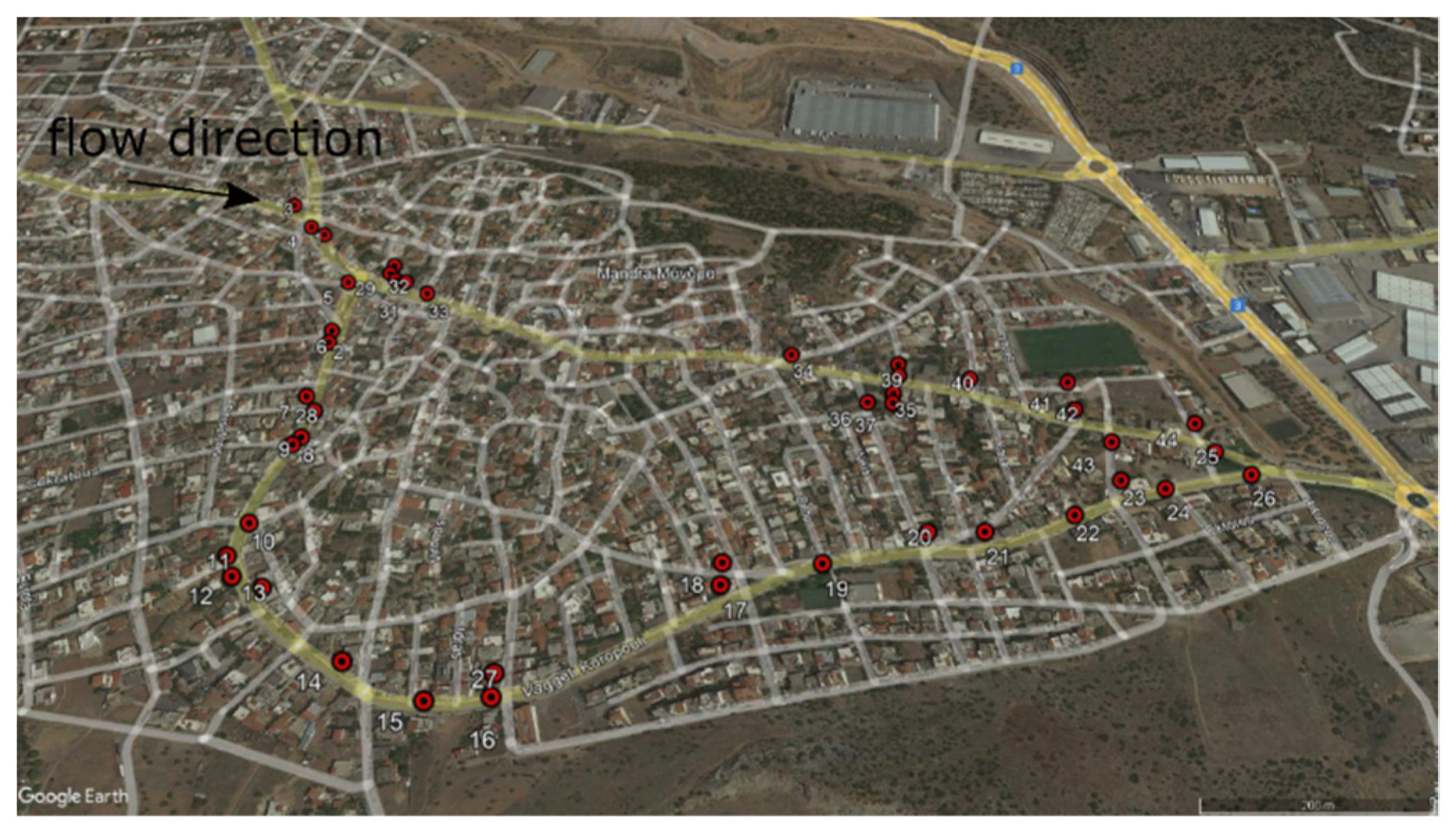
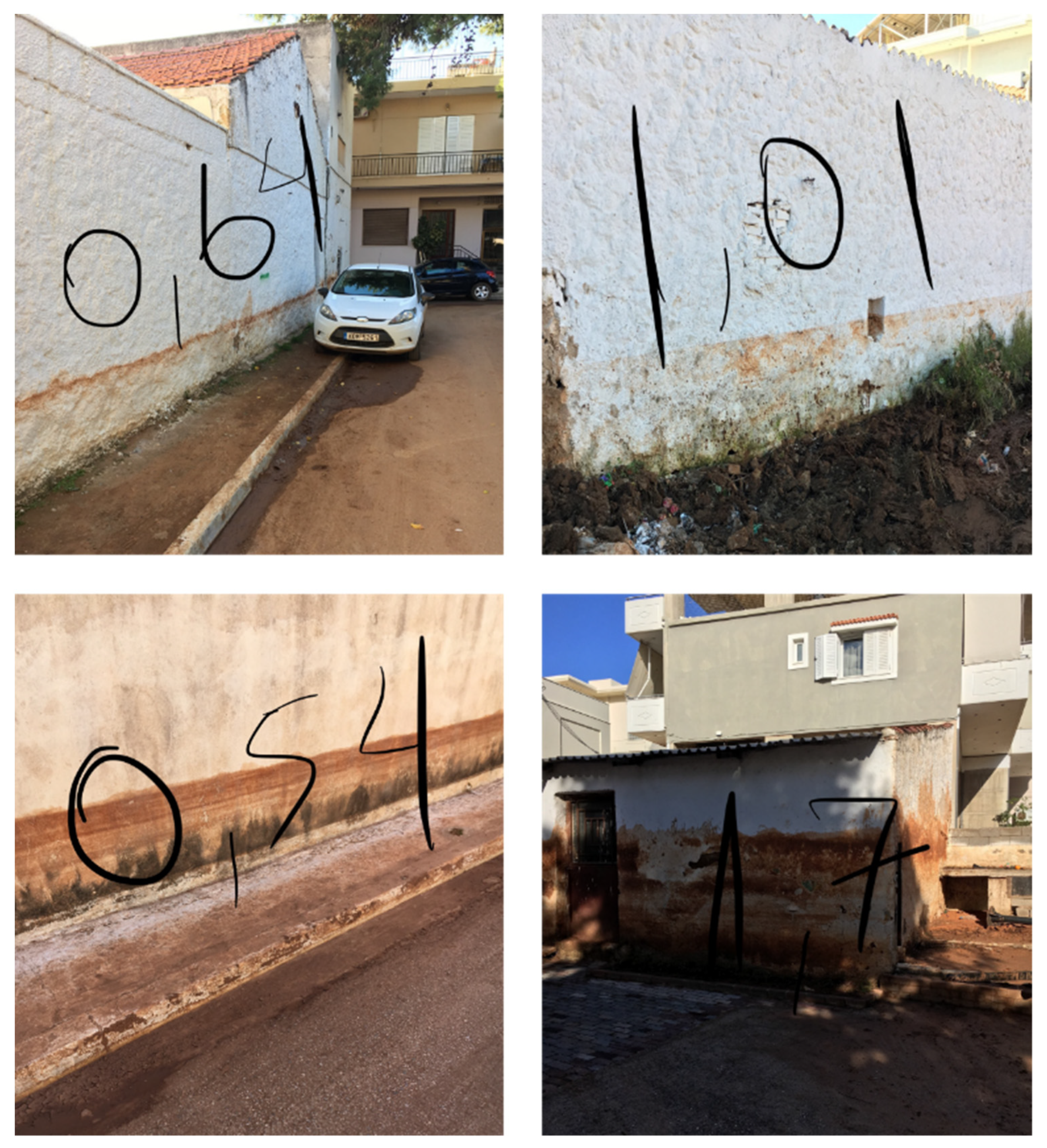
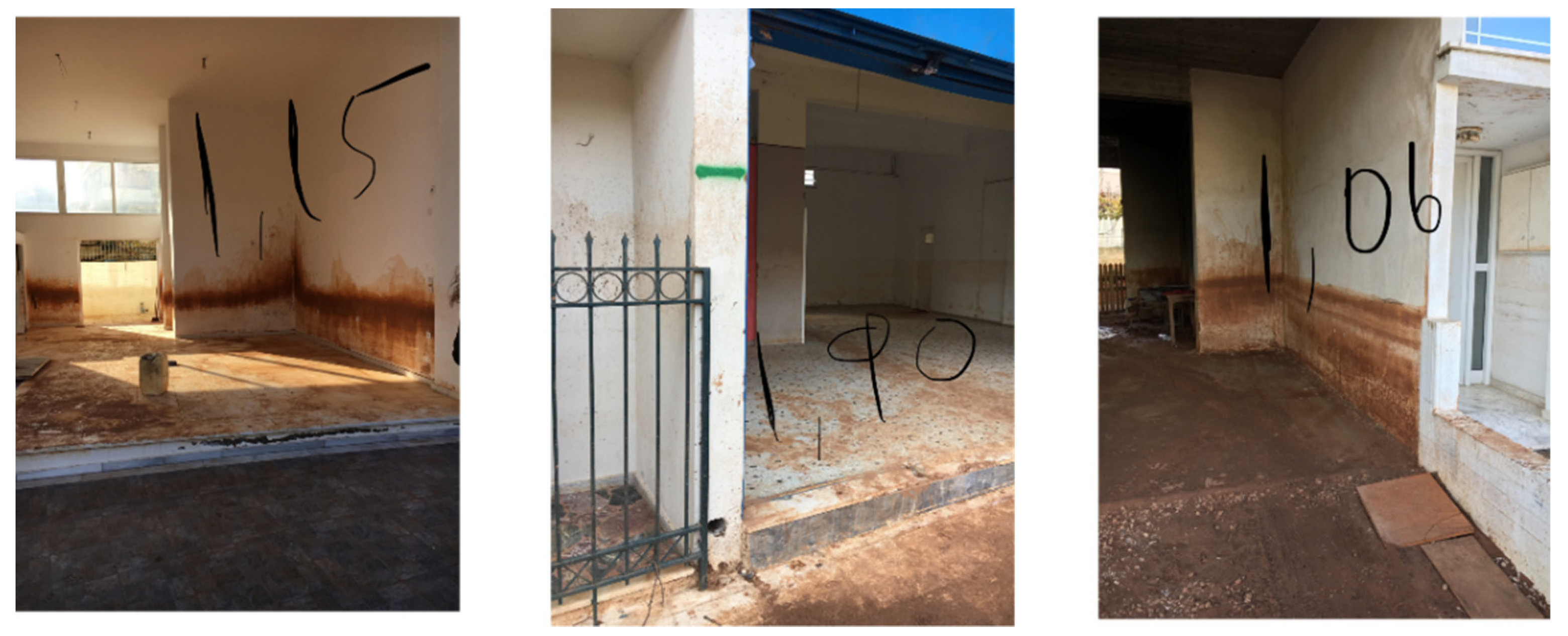
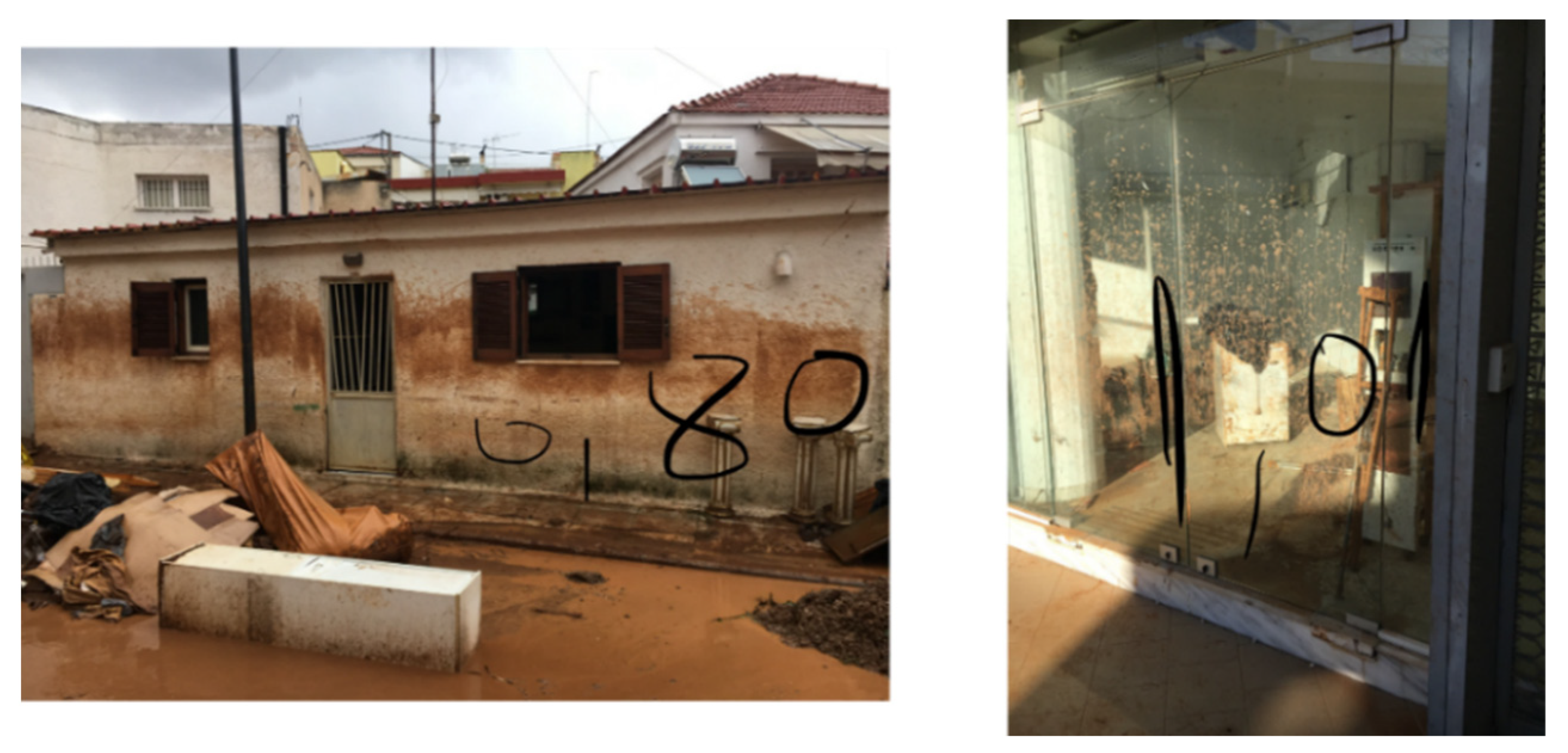
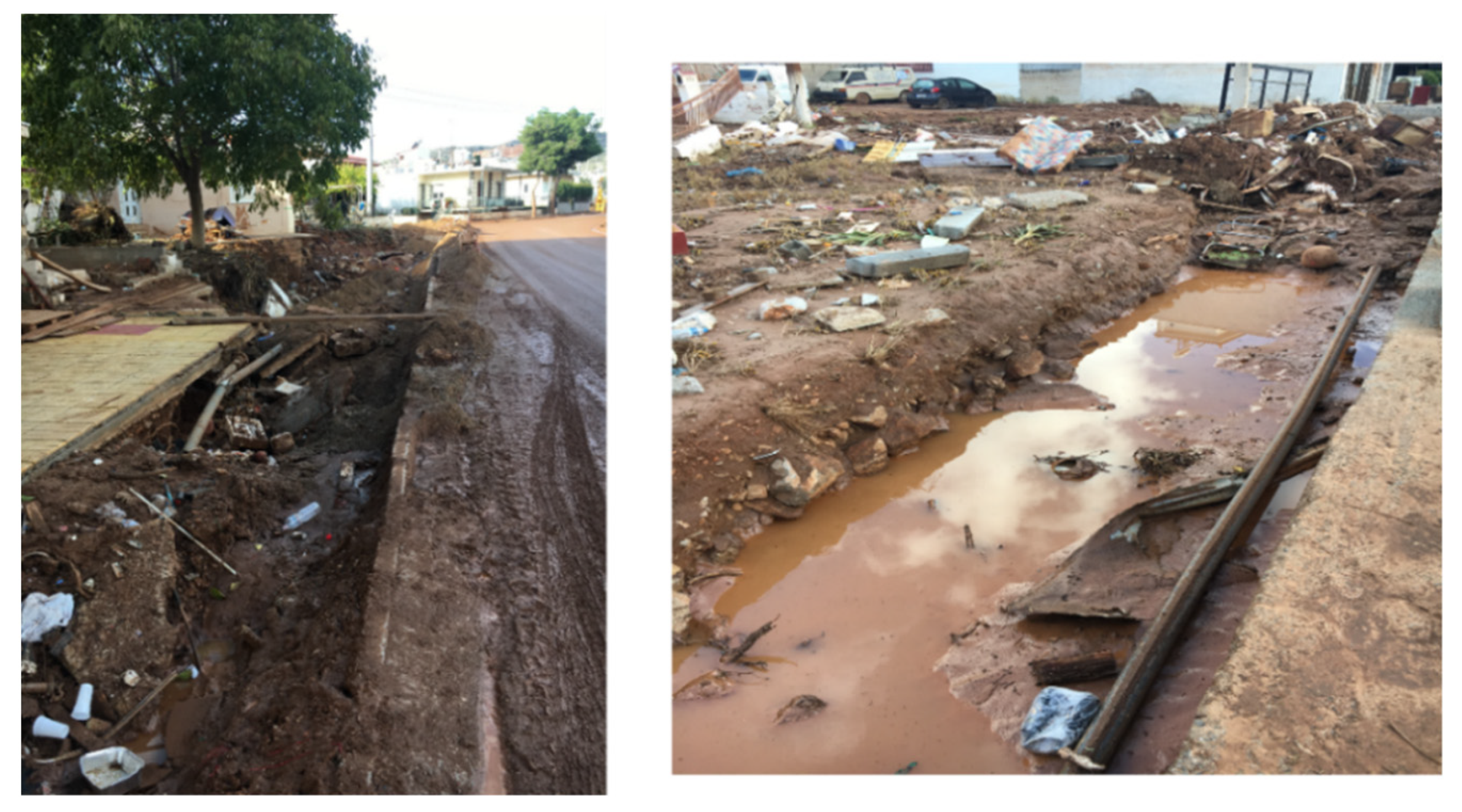
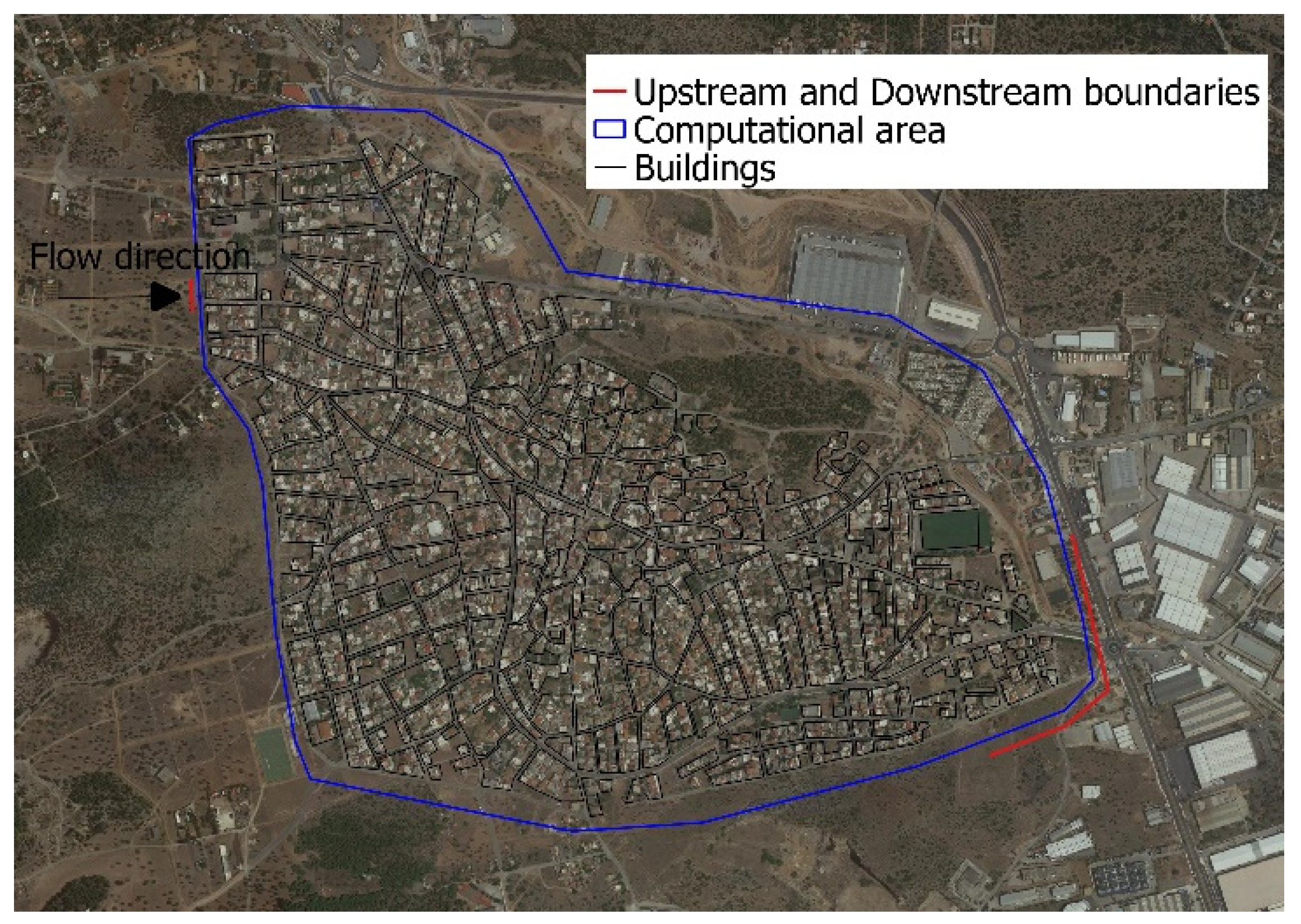
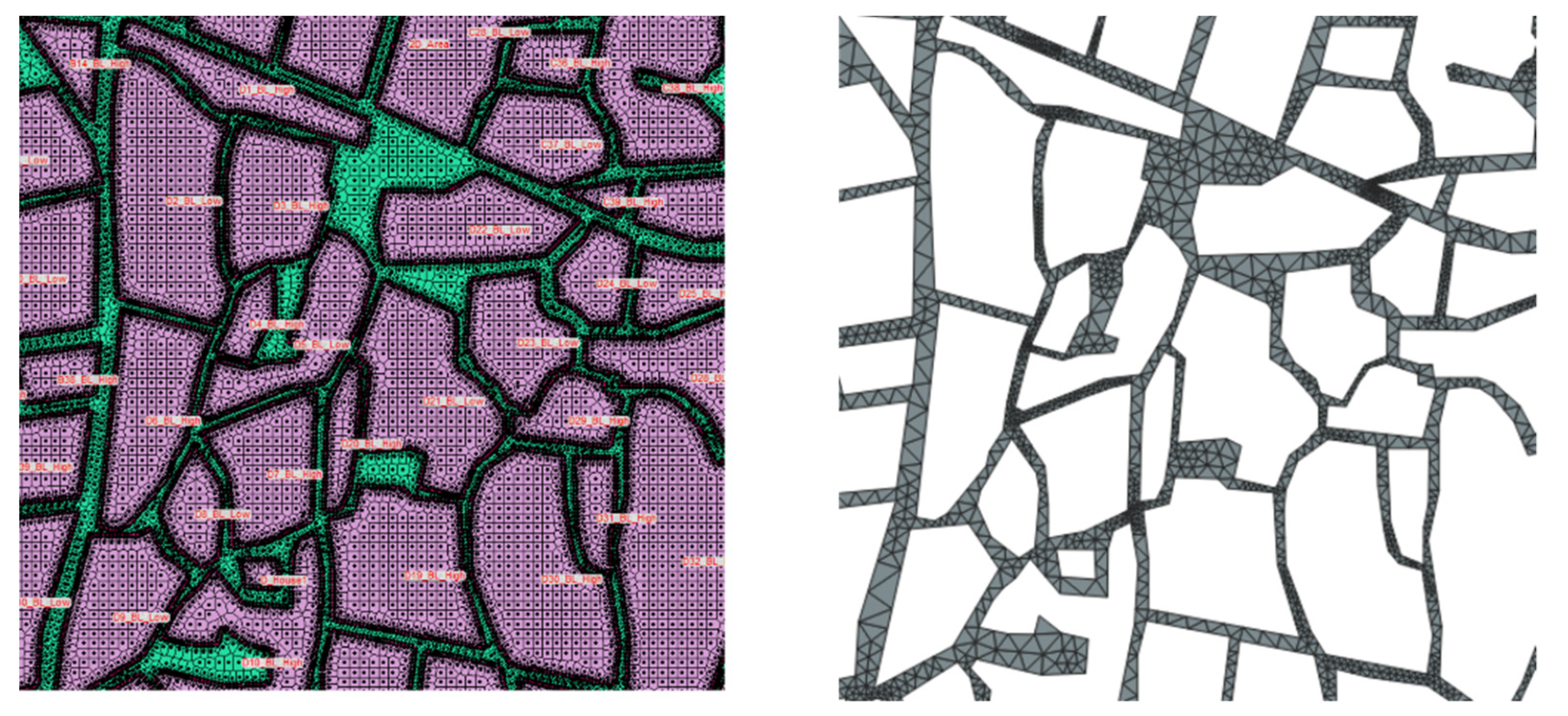
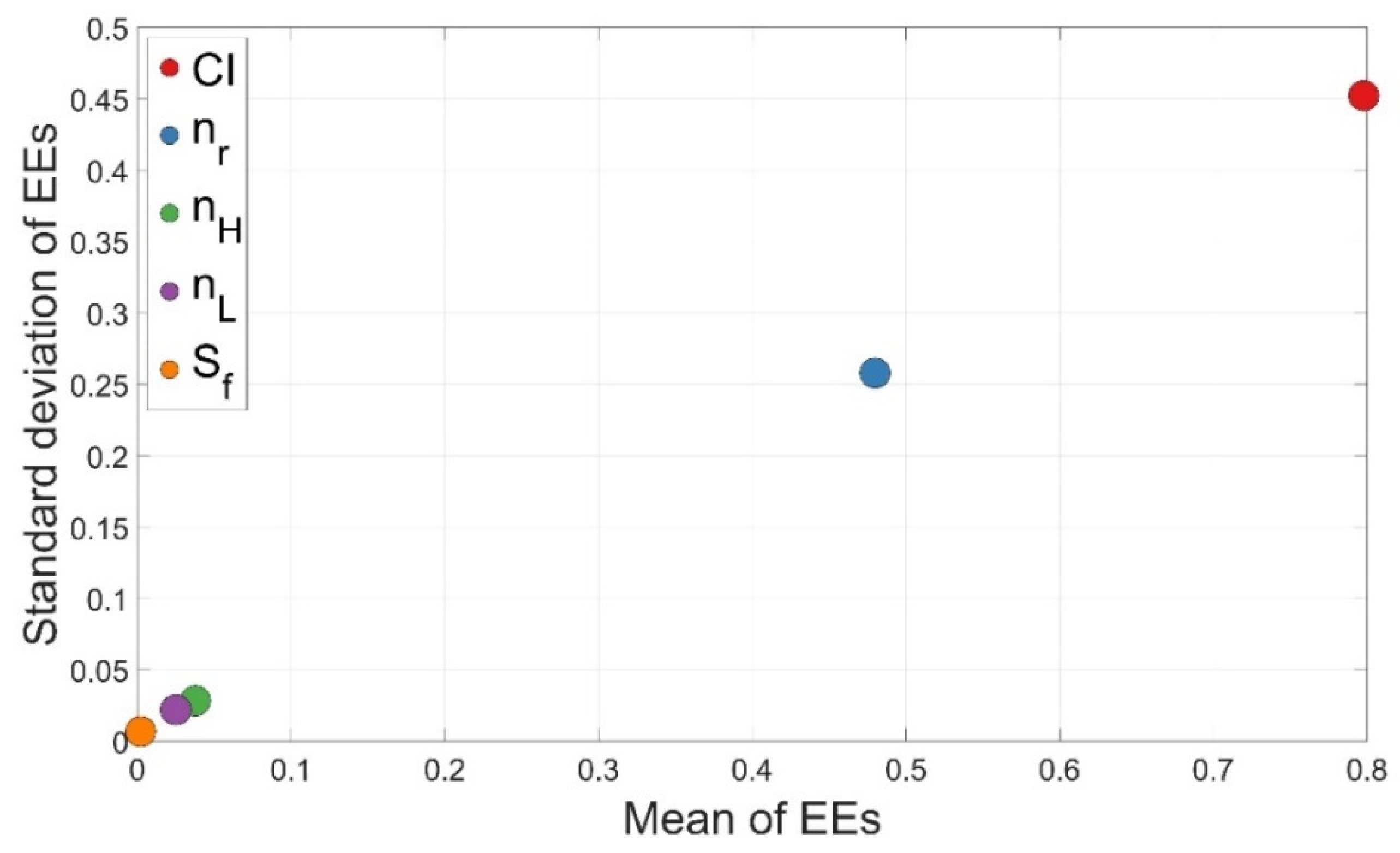
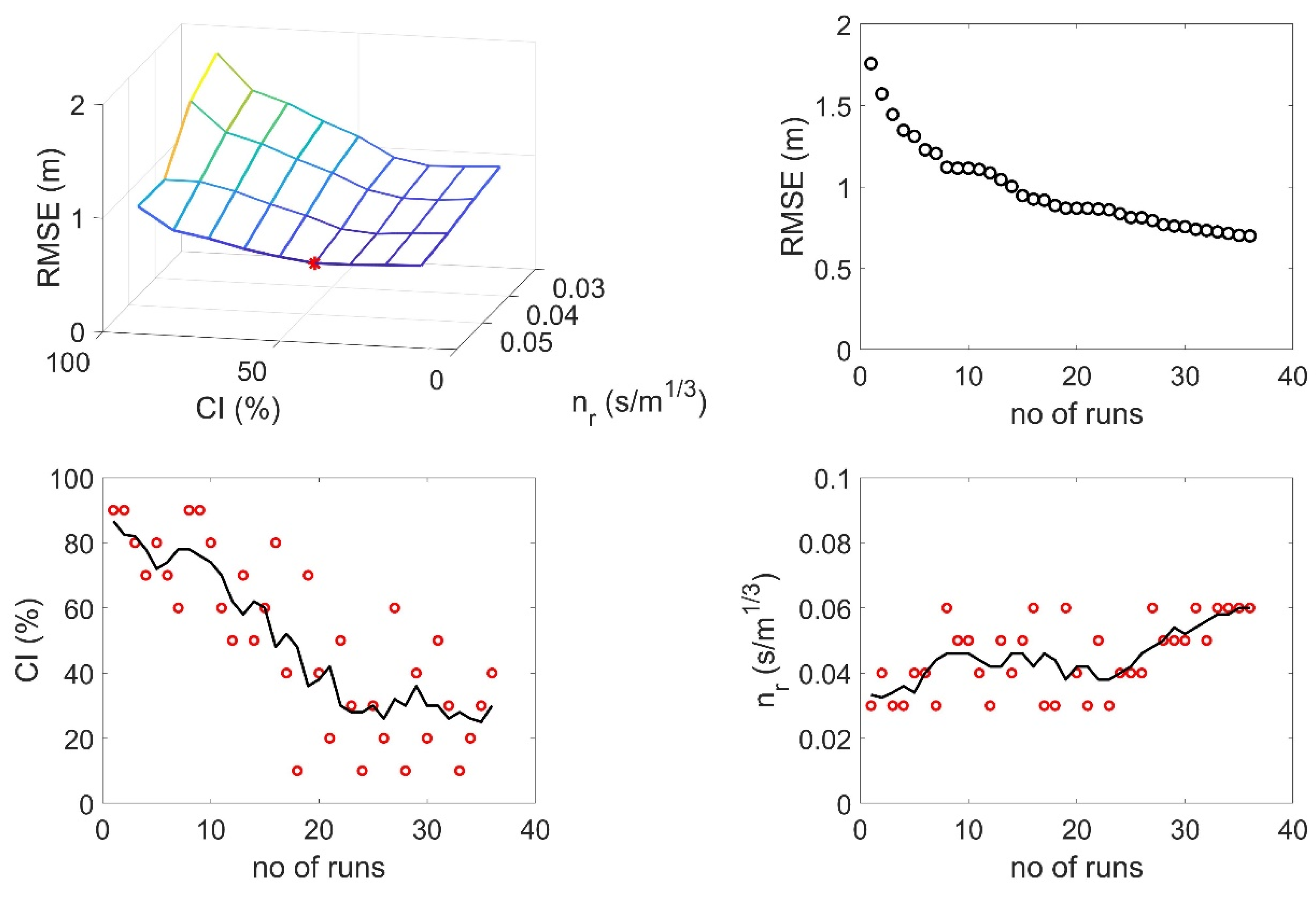
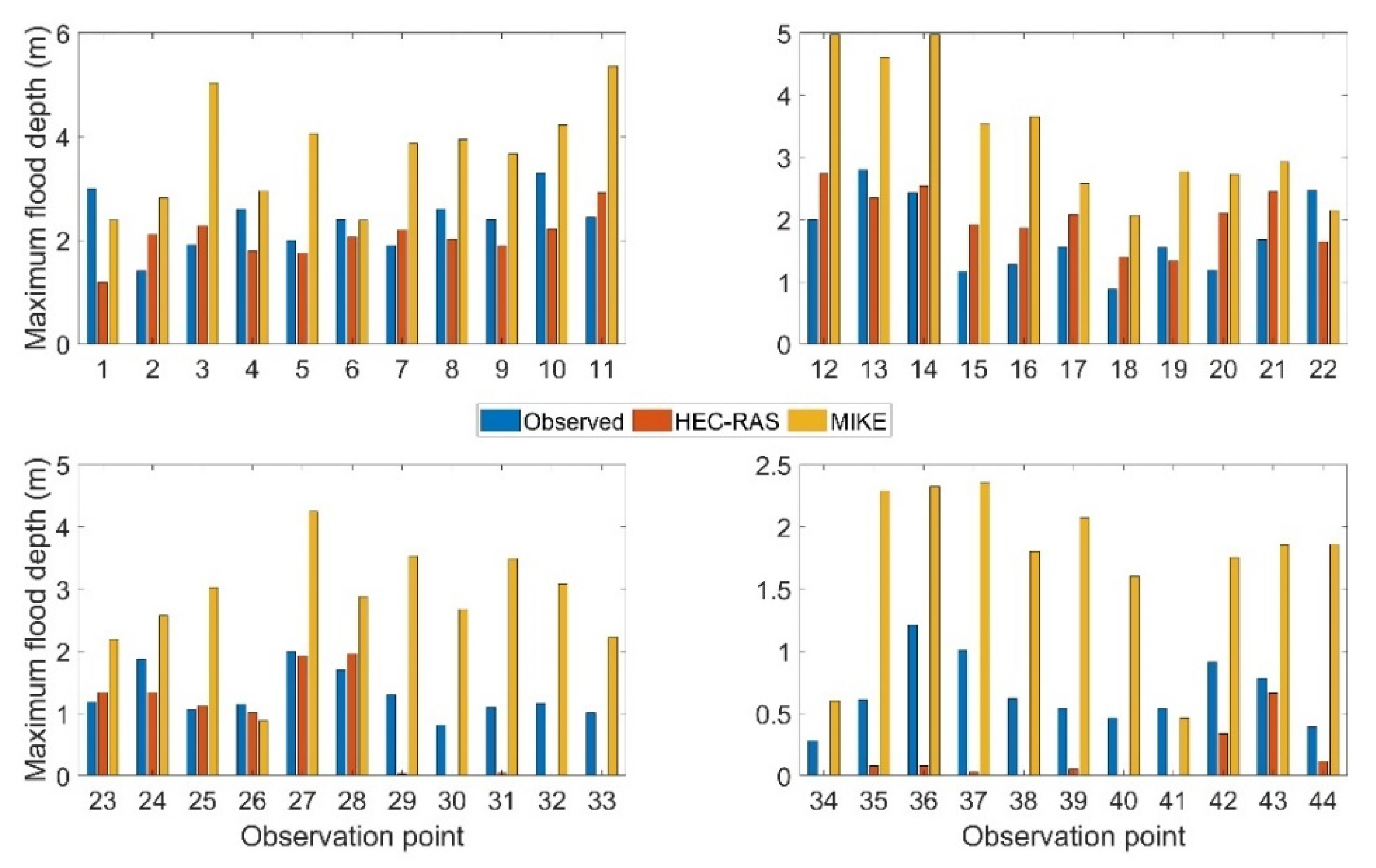
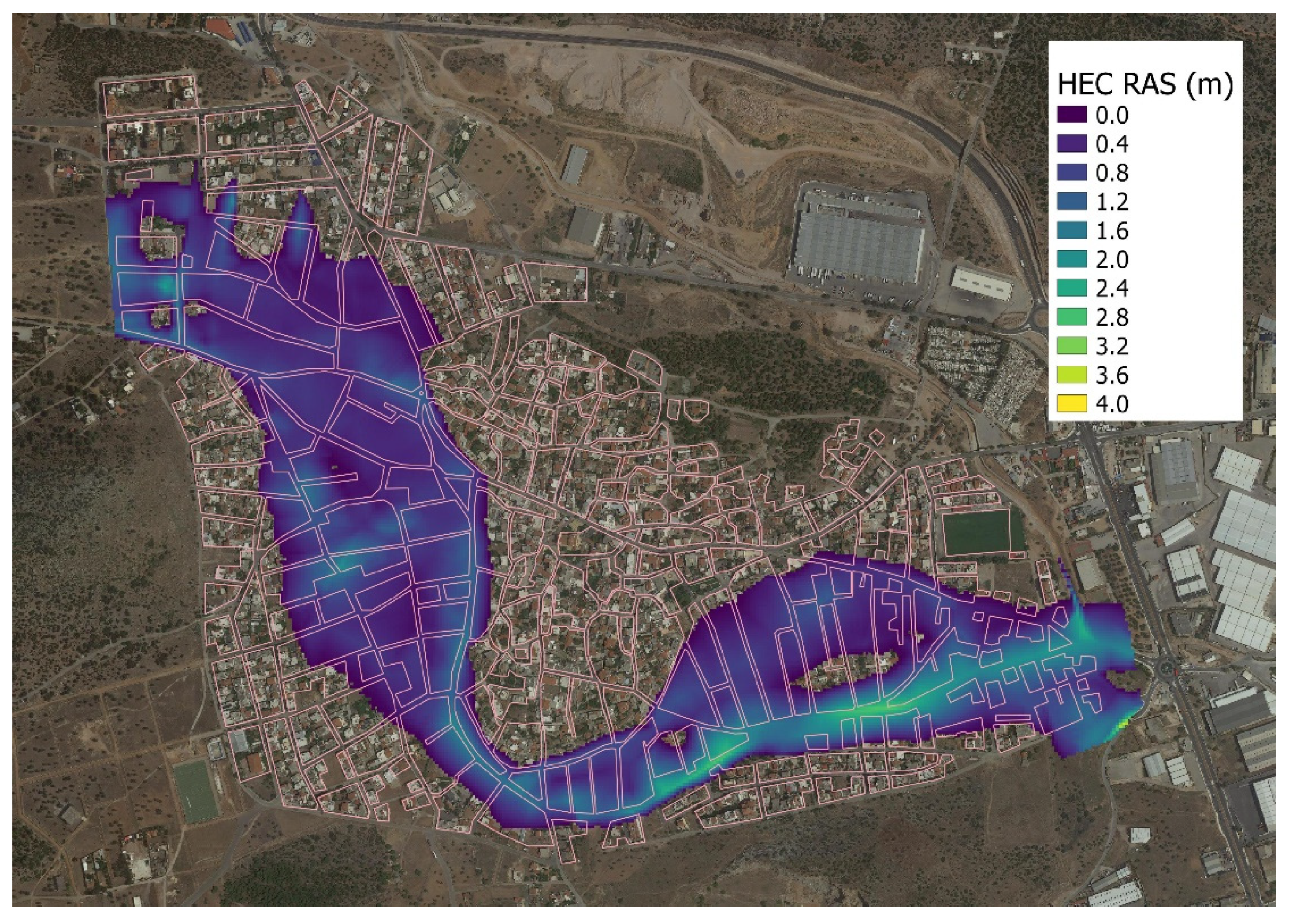
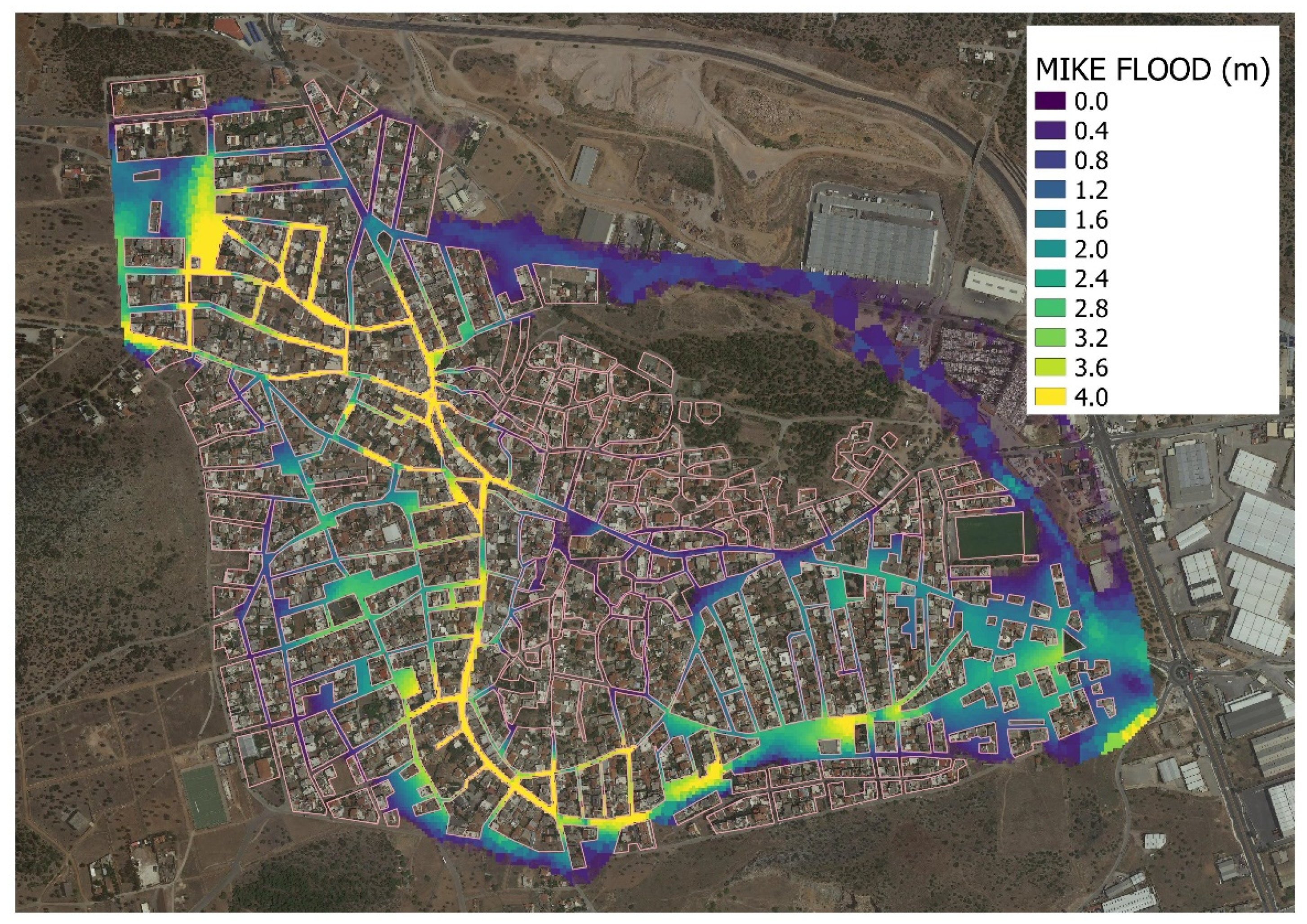


| Parameter | Lower Limit | Upper Limit |
|---|---|---|
| nr [s/m1/3] | 0.03 | 0.06 |
| nH [s/m1/3] | 40 | 60 |
| nL [s/m1/3] | 15 | 25 |
| CI [%] | 10 | 90 |
| Sf [-] | 0.01 | 0.03 |
| Gauge | X, Y (GGRS87) | φ, λ (WGS84) | Depth (m) |
|---|---|---|---|
| 1 | 455668.2588, 4214030.3444 | 38.075555095412, 23.496248974378 | 3.00 |
| 2 | 455714.0308, 4213859.4439 | 38.074017108644, 23.496781377525 | 1.41 |
| 3 | 455618.1325, 4214089.9909 | 38.076090202058, 23.495673789261 | 1.91 |
| 4 | 455648.7464, 4214045.8128 | 38.075693548981, 23.496025555384 | 2.60 |
| 5 | 455715.7245, 4213941.2321 | 38.074754298656, 23.496795637049 | 2.00 |
| 6 | 455714.7635, 4213840.7551 | 38.073848713598, 23.496790884875 | 2.40 |
| 7 | 455708.8934, 4213757.7429 | 38.073100288440, 23.496729087177 | 1.90 |
| 8 | 455718.1527, 4213696.6548 | 38.072550190317, 23.496838421089 | 2.60 |
| 9 | 455711.4275, 4213686.7258 | 38.072460378003, 23.496762362771 | 2.40 |
| 10 | 455693.3690, 4213585.9232 | 38.071551023452, 23.496562711634 | 3.30 |
| 11 | 455683.1461, 4213546.1162 | 38.071191767747, 23.496448625272 | 2.44 |
| 12 | 455694.2735, 4213521.9724 | 38.070974717633, 23.496576973349 | 2.00 |
| 13 | 455724.7554, 4213510.6998 | 38.070874612326, 23.496925173983 | 2.80 |
| 14 | 455815.0195, 4213431.7319 | 38.070167321865, 23.497959080654 | 2.43 |
| 15 | 455893.3008, 4213392.0692 | 38.069813674021, 23.498853945292 | 1.17 |
| 16 | 455950.5524, 4213396.1206 | 38.069852967810, 23.499506375731 | 1.28 |
| 17 | 456148.2251, 4213517.7609 | 38.070958813396, 23.501752448480 | 1.56 |
| 18 | 456149.9273, 4213543.6000 | 38.071191768069, 23.501770274694 | 0.88 |
| 19 | 456244.9914, 4213542.7794 | 38.071188961397, 23.502854094564 | 1.55 |
| 20 | 456349.9641, 4213582.0807 | 38.071548216307, 23.504048435197 | 1.19 |
| 21 | 456405.9467, 4213583.0278 | 38.071559443195, 23.504686605580 | 1.68 |
| 22 | 456498.3168, 4213604.9584 | 38.071761523636, 23.505738338489 | 3.00 |
| 23 | 456555.1662, 4213651.3694 | 38.072182522132, 23.506383639558 | 2.47 |
| 24 | 456597.3211, 4213639.6230 | 38.072078676069, 23.506864940258 | 1.19 |
| 25 | 456662.0088, 4213690.0413 | 38.072536158243, 23.507599370013 | 1.87 |
| 26 | 456690.6165, 4213659.3707 | 38.072261108064, 23.507927367552 | 1.06 |
| 27 | 455950.3622, 4213418.8560 | 38.070057859161, 23.499502811367 | 1.15 |
| 28 | 455722.5295, 4213734.9355 | 38.072895404700, 23.496885956174 | 2.00 |
| 29 | 455761.5685, 4213956.7620 | 38.074896496719, 23.497317344483 | 1.70 |
| 30 | 455764.4553, 4213970.1369 | 38.075017177319, 23.497349431868 | 1.30 |
| 31 | 455770.2635, 4213945.5041 | 38.074795460034, 23.497417170265 | 0.81 |
| 32 | 455783.0573, 4213940.4525 | 38.074750556643, 23.497563343334 | 1.10 |
| 33 | 455811.7063, 4213918.1875 | 38.074551291492, 23.497891341098 | 1.16 |
| 34 | 456228.1013, 4213834.3580 | 38.073815970735, 23.502643747389 | 1.01 |
| 35 | 456335.9814, 4213774.6124 | 38.073282717248, 23.503877306043 | 0.28 |
| 36 | 456306.8247, 4213760.7545 | 38.073156420710, 23.503545742317 | 0.61 |
| 37 | 456333.7110, 4213759.3652 | 38.073145194065, 23.503852350022 | 1.21 |
| 38 | 456346.2390, 4213821.5813 | 38.073706513488, 23.503991391677 | 1.01 |
| 39 | 456344.8884, 4213802.9037 | 38.073538118443, 23.503977130532 | 0.62 |
| 40 | 456422.4147, 4213797.8190 | 38.073496019748, 23.504861299648 | 0.54 |
| 41 | 456529.0244, 4213792.8917 | 38.073456726769, 23.506077031385 | 0.46 |
| 42 | 456528.4916, 4213751.4763 | 38.073083448814, 23.506073467053 | 0.54 |
| 43 | 456557.3220, 4213703.9877 | 38.072656842958, 23.506405030212 | 0.91 |
| 44 | 456652.5360, 4213731.8215 | 38.072912246041, 23.507488849352 | 0.78 |
Publisher’s Note: MDPI stays neutral with regard to jurisdictional claims in published maps and institutional affiliations. |
© 2022 by the authors. Licensee MDPI, Basel, Switzerland. This article is an open access article distributed under the terms and conditions of the Creative Commons Attribution (CC BY) license (https://creativecommons.org/licenses/by/4.0/).
Share and Cite
Bellos, V.; Kourtis, I.; Raptaki, E.; Handrinos, S.; Kalogiros, J.; Sibetheros, I.A.; Tsihrintzis, V.A. Identifying Modelling Issues through the Use of an Open Real-World Flood Dataset. Hydrology 2022, 9, 194. https://doi.org/10.3390/hydrology9110194
Bellos V, Kourtis I, Raptaki E, Handrinos S, Kalogiros J, Sibetheros IA, Tsihrintzis VA. Identifying Modelling Issues through the Use of an Open Real-World Flood Dataset. Hydrology. 2022; 9(11):194. https://doi.org/10.3390/hydrology9110194
Chicago/Turabian StyleBellos, Vasilis, Ioannis Kourtis, Eirini Raptaki, Spyros Handrinos, John Kalogiros, Ioannis A. Sibetheros, and Vassilios A. Tsihrintzis. 2022. "Identifying Modelling Issues through the Use of an Open Real-World Flood Dataset" Hydrology 9, no. 11: 194. https://doi.org/10.3390/hydrology9110194
APA StyleBellos, V., Kourtis, I., Raptaki, E., Handrinos, S., Kalogiros, J., Sibetheros, I. A., & Tsihrintzis, V. A. (2022). Identifying Modelling Issues through the Use of an Open Real-World Flood Dataset. Hydrology, 9(11), 194. https://doi.org/10.3390/hydrology9110194








